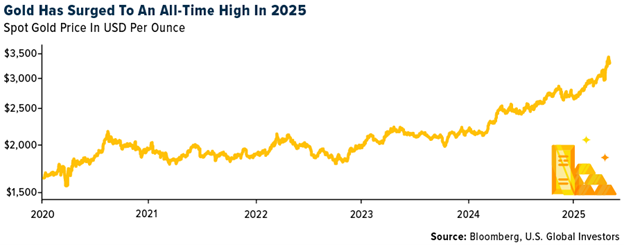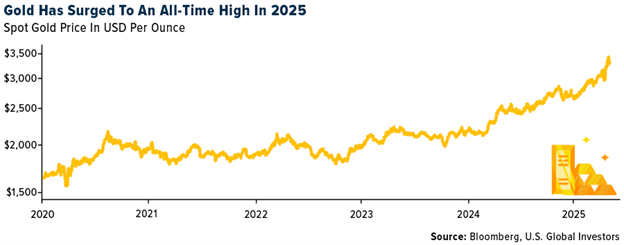Strengths
- Silver outperformed this week, rising 1.56%. While gold’s recent surge underscores its role as a hedge during turbulent times, silver, often a late-cycle performer, may now offer greater upside given its dual function as both a safe haven and an industrial metal. With the gold-silver ratio historically stretched (currently around 99), past patterns suggest silver could soon outperform if economic conditions stabilize, according to Bloomberg.
- K92 Mining posted strong Q1/25 results, reporting gold equivalent production of 47,817 ounces—nearly double estimates—driving estimated revenue of $124 million, cash costs of $578/oz, and an all-in sustain cost (AISC) of $1,218/oz. However, adjusted earnings per share (EPS) of $0.23 came in slightly below consensus. With record production and stronger cash reserves in 2024, K92 is positioned for a transformational 2025 as it advances its Stage 3 expansion at Kainantu, targeting 168,000oz AuEq production and enhanced milling capacity. Canaccord raised its target price to C$16.00, maintaining a BUY rating.
- Assets under management at physically backed gold ETFs continue to climb, led by inflows of 26 tons in the U.S. and 20 tons in China at the start of April. Year-to-date (YTD), investors have increased exposure to these vehicles by 9.1% or 293 tons, according to the World Gold Council (WGC).

Weaknesses
- Palladium was the weakest performing precious metal, down 2.43% for the week. Continued ETF outflows and weakening investor demand contributed to palladium’s 2.5% year-to-date decline. Unlike platinum, which saw modest inflows this week, palladium’s dual exposure to industrial use and speculative flows leaves it vulnerable to shifting sentiment.
- Environmental permits at Laiva Gold’s Laivakangas mine in Finland were revoked following “years of breaches that caused environmental damage and risks,” according to a local authority. Financial difficulties at the company were cited as a partial cause, according to the Regional State Administrative Agency’s statement on Tuesday.
- Hochschild Mining reported lower-than-expected Q1 production, with attributable output of 79,900oz of gold, missing BMO’s forecast of 84,200oz. Production declined quarter-over-quarter as expected due to seasonality. Mara Rosa was particularly impacted by heavier-than-anticipated rainfall, limiting access to high-grade open-pit zones and resulting in output of 16,000oz versus the forecasted 19,900oz.
Opportunities
- China is considering setting up overseas gold warehouses to support international settlements via the Shanghai Gold Exchange, according to the People’s Bank of China (PBOC). This move aims to expand the use of the RMB benchmark internationally. The Shanghai International Gold Exchange is key to China’s de-dollarization push, offering RMB reserve holders the opportunity to convert into gold. The RMB is now used for most inbound and outbound transactions, according to the China State Administration of Foreign Exchange.
- The S&P/TSX Gold Index (USD) has broken out above its last cyclical high from August 2024. Since February 2024, the index is up 104%, while gold has risen 64%. Despite strong equity performance, valuations remain inexpensive. Canaccord notes that senior producers are trading at 0.62x NAV compared to their historical average of 0.80x (±1.5 standard deviations).
- Triple Flag Precious Metals (TFPM) announced an agreement to acquire 100% of Orogen Royalties for C$421 million (or C$2.00/share), comprising C$171.5 million in cash, C$171.5 million in TFPM shares, and C$78 million in shares of the new Orogen SpinCo. Orogen shareholders may elect either C$1.63/share in cash or 0.05355 TFPM shares per Orogen share, plus 0.25 shares in the SpinCo, representing approximately $0.37/share in value. TFPM will finance the deal through its existing $700 million undrawn credit facility, according to CIBC.
Threats
- Gold’s rally may be overstretched, as implied volatility rises alongside spot prices. Three-month implied volatility on the SPDR Gold Shares ETF—viewed as a proxy for gold’s volatility—is climbing. Similar spikes in 2020 and 2022 preceded declines in gold prices amid broader risk-off environments. As implied volatility rises with prices, positioning becomes crowded, raising market sensitivity to profit-taking, Bloomberg reports.
- Retail interest in gold stocks has reached peak levels comparable to prior market tops in 2020 and 2011, according to RBC. Concerns are growing that the current strength of the rally, combined with existing positioning, could limit further upside.
- Investors pulled $1.27 billion from the SPDR Gold Shares ETF earlier this week—the largest one-day outflow since 2011. This occurred just as bullion hit an all-time high above $3,500/oz, suggesting profit-taking may be underway, according to Bloomberg.

